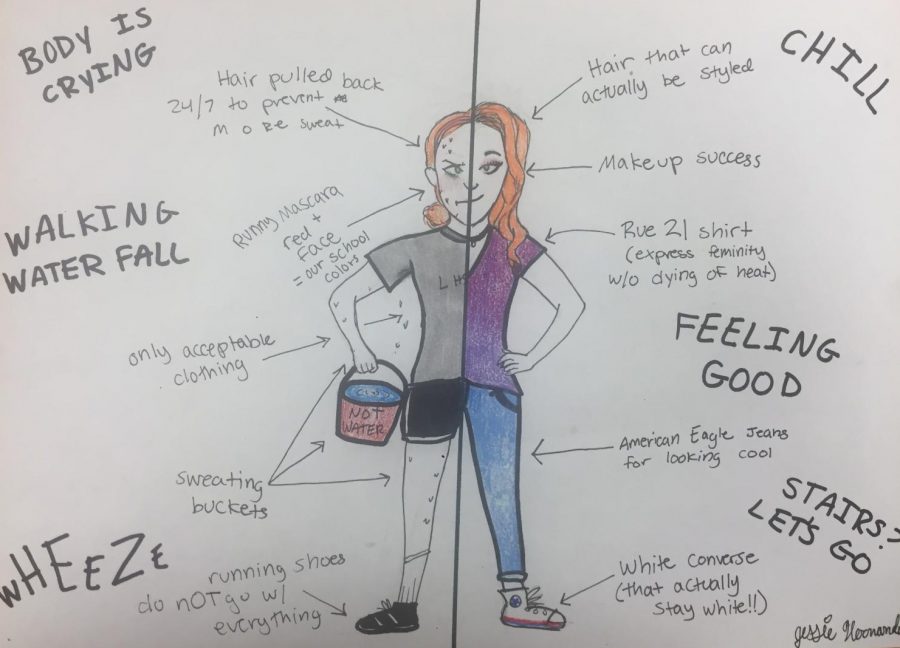No sweat: Gym should not be required for athletes
Love exercise but hate gym class?
September 24, 2018
Amidst all of the excitement of the new school year, one thing has not changed — gym class. For decades, students have replaced school clothes with running shoes and braved a semester of enforced physical activity. From haphazard volleyball games to the dreaded PACER Test, gym class is familiar to all freshmen.
From my personal experience, gym has always been a “get it over with” kind of class. This year, I have gym class first period, and by second period, I am red-faced, sweaty, and worn out. It’s not that I hate exercise--I love it. For me, and many other athletes, it’s the inconvenience of having to fulfill a credit first period when I’m already running for cross county for two hours at practice every day.
“Whether students should have to take a formal physical education class, especially if they are on a sports team” is not a new debate topic. But today, with so many students competing on school and travel teams outside of the formal school day, and with these sports growing more competitive and intense, it’s time for change.
One of the main arguments concerns the repetition. The purpose of gym class is to get students moving and to increase physical activity. According to the Center for Disease Control and Prevention (CDC), children and adults should be active for at least 60 minutes a day. Taking a physical education class meets this expectation, but only for 9 weeks out of the 144 weeks a student is in high school. That’s a mere fraction of a student’s high school experience.
However, if a student is involved in a sport, they are spending at least, if not more, time than this being active. This makes the added time spent in a gym class excessive. I estimate that my season of cross country, which begins in August and ends in late October, racks up 108 hours of practice (minimum). My formula is 54 days of practice for 2 hours each day. Plenty of sports teams practice more than this, and my estimate doesn’t include games or meets.
Varsity soccer captain Christian Nolan said, “I was definitely more active during during soccer practice than gym class.”
Another purpose of gym class is to teach students team dynamic and competitive etiquette. However, if a student is on a sports team, wouldn’t these things be taught within the sport? High school coaches do not tolerate unsportsmanlike behavior, and team dynamic is formed naturally through getting to know teammates.
One of the most important lessons students are supposed to gain from physical education classes is healthy habits to carry throughout their lives. But, student athletes are already applying these skills and habits in their lives because the success of their team relies on it.
Fitness programs in schools aren’t irrelevant. They teach important skills and motivate students to be more conscious of their health and fitness.
Physical educaiton teacher Andrea Poffinberger believes the course is necessary. “These classes teach students important aspects of fitness and health including the benefits of exercise, teamwork, goal setting, and growth.”
Despite all of my complaining, I think health classes do have an important place in high school education. It is important for students to be informed about their physical and mental health to prepare them for life outside of high school. But, I believe that once taught these skills and information in a health class, it should be a choice whether a student implements them in their life, it shouldn’t be forced. For a long time, many have argued that Health should be more than a half credit. There are plenty of topics students don’t cover. Maybe that is a good solution.
I recognize that it would be difficult to prove that a student is actively participating on a sports team, and the line is blurry as to what counts as “regular physical activity.” Would all sports count, or does a student have to be on varsity? How long does a student have to participate in the sport for it to count?
What if an injury occurs in the middle of the season? Additionally, what is included under the blanket term of “physical activity”? Do other physically tasking activities such as marching band or color guard count? There’s no question that Color Guard and Marching band students are experiencing a lot of physical exercise.
All of these questions and many more are relevant and would need to be discussed before any change could occur.
Physical fitness is important, and being active should be a priority in students’ lives, but there needs to be flexibility.
Forcing students to take a gym class won’t ensure they continue the habits they are taught. Instead, students should be given the choice what to do with their time. Being given this responsibility in high school will teach students how to balance different aspects of their lives. Gym class should be an option, not an obligation.






